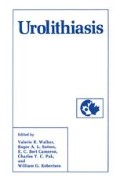Abstract
Extracorporeal shock-wave lithotripsy (ESWL) has introduced a tremendous change in the management of patients with urinary stones. Patient morbidity has decreased as compared to other methods of stone removal, and only 10–25% of all patients need subsequent stone-particle manipulation by secondary percutaneous or transurethral methods. Impacted or very hard calculi in the ureter, especially when they are not surrounded by fluid, can only be crushed in about 40–50% of cases in situ, while the rest of the stone material has to be flushed up to the kidney and be disintegrated there. This procedure has to be done with small catheters or an endoscope since direct access to the stone is mandatory. Thus, there is still need for ureteroscopic manipulation.
Access this chapter
Tax calculation will be finalised at checkout
Purchases are for personal use only
Preview
Unable to display preview. Download preview PDF.
References
FP Begun, SC Jacobs, and RK Lawson, Shock-wave lithotripter pressure field analysis, Am. Urol. Assoc. Annual Meeting, Anaheim, California, (1987).
R Hofmann and W Schütz, Zerstörung von Harnsteinen durch Laser-strahlung, Urologe A 23:181 (1984).
R Hofmann, R Härtung, K Geissdörfer, R Ascherl, W Erhardt, H Schmidt-Kloiber, and E Reichel, Laser induced shock wave lithotripsy: biological effects of nanosecond pulses, J. Urol. 139:1077 (1988).
JE Lingeman, TA Coury, DM Newman, and RJ Kahnoski, Comparison of results and morbidity of percutaneous nephrostolithotomy and extracorporeal shock wave lithotripsy, J. Urol. 138:485 (1987).
RA Riehle, HB Carter, and ED Vaugh, Quantitative and crystallographic analysis of stone fragments voided after extracorporeal shock wave lithotripsy, J. Endourology 1:37 (1987).
H Schmidt-Kloiber, E Reichel, and H Schöffmann, Laser induced shoch wave lithotripsy (LISL), Biomed. Technik 30:173 (1985).
G Watson, S Murray, SP Dretler, and JA Parrish, The pulsed dye laser for fragmenting urinary calculi, J. Urol. 138:195 (1987).
Author information
Authors and Affiliations
Editor information
Editors and Affiliations
Rights and permissions
Copyright information
© 1989 Springer Science+Business Media New York
About this chapter
Cite this chapter
Hofmann, R., Hartung, R., Schmidt-Kloiber, H., Reichel, E. (1989). Intracorporeal Laser-Induced Shock-Wave Lithotripsy. In: Walker, V.R., Sutton, R.A.L., Cameron, E.C.B., Pak, C.Y.C., Robertson, W.G. (eds) Urolithiasis. Springer, Boston, MA. https://doi.org/10.1007/978-1-4899-0873-5_288
Download citation
DOI: https://doi.org/10.1007/978-1-4899-0873-5_288
Publisher Name: Springer, Boston, MA
Print ISBN: 978-1-4899-0875-9
Online ISBN: 978-1-4899-0873-5
eBook Packages: Springer Book Archive

